#“U.S. Indo-Pacific command
Video
#USINDOPACOM#U.S. Indo-Pacific Command#Arctic#LR#Alaska#U.S. Marine Corps Aviation#Joint Base Elmendorf-Richardson#USA#flickr
4 notes
·
View notes
Text
14 Aug 23
With the deadline for residents to weigh in on the proposed 360-degree missile defense system for Guam passing Friday, demonstrators gathered at the Chief Kepuha Park roundabout in Hagåtña for a protest for peace.
Members of activist group Prutehi Litekyan: Save Ritidan and Independent Guåhan, as well as other concerned citizens, stood along the roadside holding signs emblazoned with the slogans "No war for Guåhan," "Defend the sacred!" and "No more imperialist war games" as the evening traffic rush ramped up.[...]
Beyond raising concerns regarding the environment, natural and cultural resources, and land that the group has raised with previous military construction projects, Flores said she doesn't believe the system will bring more security for Guam.
"It's really important that we ask ourselves what genuine security means," she said. "It ... definitely means more than national security. It means having clean water, living in our homeland without the risk of war ... and we feel that the missile defense system definitely makes us a bigger target for war."
Though the system is being sold as a way to protect Guam, its purpose is to help use Guam as a base for the U.S. military to project force and protect the nation, she said.[...]
U.S. Indo-Pacific Command has called the Guam Defense System the top national defense priority for the region.
19 Aug 23
459 notes
·
View notes
Text

NORAD head said Chinese aircraft may start operating near the US this year
Fernando Valduga By Fernando Valduga 13/03/2024 - 09:00 in Military
U.S. Air Force General Gregory M. Guillot, the new head of the North American Aerospace Defense Command (NORAD) and the U.S. Northern Command (NORTHCOM), warned lawmakers on March 12 that Chinese warplanes could start operating near the U.S. Air Defense Identification Zone (ADIZ) as early as this year.
“Fortunately, we have not yet seen Chinese aircraft operating near our air defense identification zones, but I think this will happen as early as this year,” Guillot told the House Armed Services Committee in his first testimony in Congress since he took office as NORAD and Commander of NORTHCOM in February. "This shows a general concern I have about China's growing capacity, not only with aircraft, but also with ships and even submarines capable of moving further away from China and getting closer to our coasts."
youtube
Air Defense Identification Zones are buffer regions that extend beyond territorial borders, covering airspace hundreds of kilometers from the coast that nations use to track approaching aircraft. NORAD tracks aircraft using a network of satellites, ground and air radars and combat aircraft, and all aircraft entering or leaving U.S. airspace from abroad must be identified in advance.
Russian fighters and bombers regularly enter the U.S. ADIZ, without entering U.S. or Canadian airspace. Occasionally, NORAD sends fighters to intercept these aircraft and escort them out of ADIZ. In February, NORAD reported three occurrences of Russian aircraft operating in the Alaskan ADIZ.
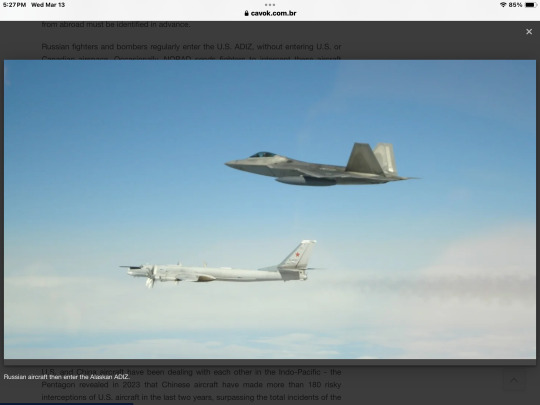
Russian aircraft then enter the Alaskan ADIZ.
The entry of Chinese aircraft into the US ADIZ, however, would mark an expansion of the reach of the People's Liberation Army. In recent years, the ELP has entered ADIZ around the island of Taiwan hundreds of times, sometimes sending dozens of planes in a single day, in movements that observers warn that they may be probing Taiwan's defenses or inducing them to a feeling of complacency.
U.S. and China aircraft have been dealing with each other in the Indo-Pacific - the Pentagon revealed in 2023 that Chinese aircraft have made more than 180 risky interceptions of U.S. aircraft in the last two years, surpassing the total incidents of the previous decade, increasing concerns about China's unpredictable and increasingly provocative behavior.
At the same time, Chinese surveillance balloons entered U.S. airspace five times in recent years, with the Pentagon losing several at the time they occurred, before one of them crossed the entire U.S. continental territory in January 2023, eventually being shot down after a few days.
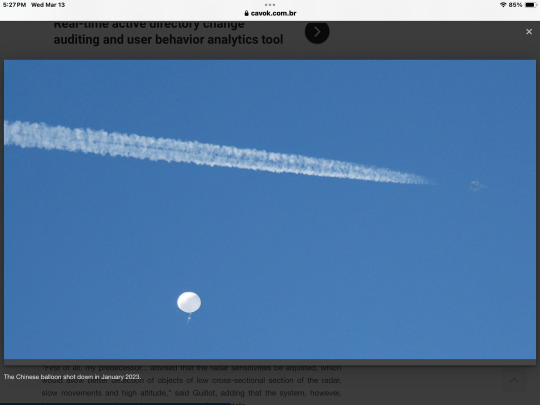
The Chinese balloon shot down in January 2023.
Guillot told lawmakers that NORAD has taken steps to better identify objects such as spy balloons that may have gone unnoticed in the past, filling the "domain knowledge gap" highlighted by his predecessor, General Glen D. VanHerck.
"First of all, my predecessor... advised that the radar sensitivities be adjusted, which would allow better detection of objects of low cross-sectional section of the radar, slow movements and high altitude," said Guillot, adding that the system, however, introduces some confusion due to the receipt of more data.
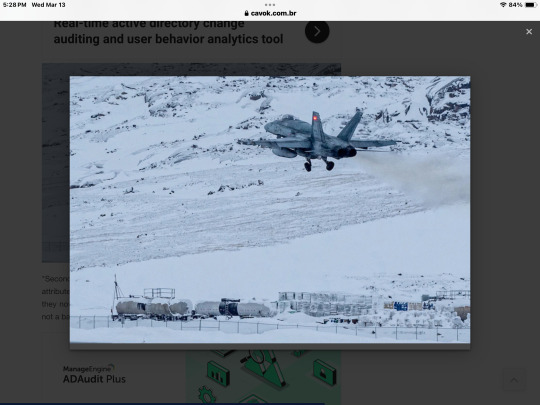
"Secondly, when our operators see intermittent hits that in the past would generally be attributed to the weather or other phenomena that would cause an inconsistent hit, they now continue to track them with more care and consistency to ensure that it is not a balloon or some other phenomenon," Guillot said.
"And the third is a better recognition of dominance among the other combatant commands. As we get the JADC2... the ability to share data from one combatant command to another, instead of stopping on a black line on a map that divides the regions, we can now share that information electronically in a transparent way to increase our consciousness even further away from our backs.”
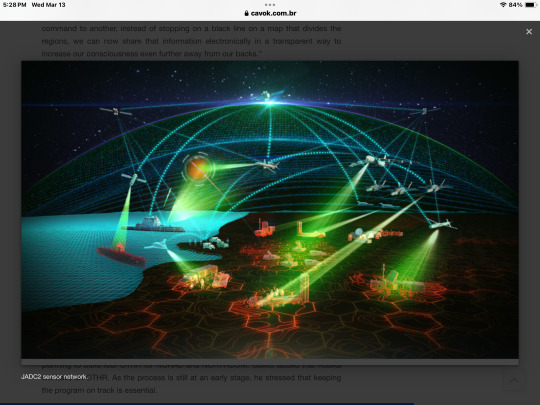
JADC2 sensor network.
Still, Guillot said that the surveillance systems of NORAD and NORTHCOM need more investments, calling radar beyond the horizon (OTHR) and the long-range discrimination radar (LRDR) as their "main priorities".
The Missile Defense Agency said in January that an LRDR missile defense system in Alaska is almost complete and will start operating at the end of this year. Both the U.S. and Canadian military have invested in the OTHR, with the U.S. Air Force planning to build four OTHR for NORAD and NORTHCOM. Guillot added that Alaska will have an OTHR. As the process is still at an early stage, he stressed that keeping the program on track is essential.
“This would give us capability against cruise missiles, traditional airstrips, as well as hypersonic weapons,” Guillot said. "Keeping this program on track is NORTHCOM's number one priority, due to the large capacity it would bring."
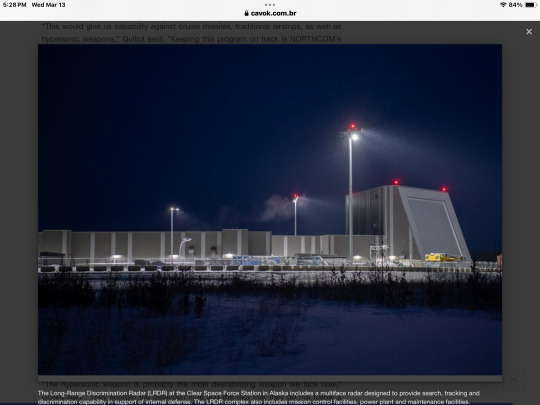
The Long-Range Discrimination Radar (LRDR) at the Clear Space Force Station in Alaska includes a multiface radar designed to provide search, tracking and discrimination capability in support of internal defense. The LRDR complex also includes mission control facilities, power plant and maintenance facilities.
Guillot added that hypersonic weapons pose a greater threat than intercontinental ballistic missiles (ICBMs) due to their ability to fly at lower altitudes and maneuverability.
“The hypersonic weapon is probably the most destabilizing weapon we face now,” Guillot said. "They shorten the detection time and the fact that they do not follow a traditional ballistic track means that they are very unpredictable and the area of uncertainty is huge, based on their speed and manoeuvrability. That's what makes them a challenge not only to detect, but also to track and eventually defeat."
Source: Air & Space Forces Magazine
Tags: Military AviationNORADPLAAF - China Air Force
Sharing
tweet
Fernando Valduga
Fernando Valduga
Aviation photographer and pilot since 1992, he has participated in several events and air operations, such as Cruzex, AirVenture, Dayton Airshow and FIDAE. He has works published in specialized aviation magazines in Brazil and abroad. He uses Canon equipment during his photographic work in the world of aviation.
Related news
MILITARY
Denmark prepares for delays in the delivery of F-35 fighters and seeks alternatives
13/03/2024 - 08:15
MILITARY
F-35 program reaches milestone C and full rate production
12/03/2024 - 23:37
HISTORY
Airbus C295 reaches 300 orders: learn interesting facts about this leading global aircraft
12/03/2024 - 22:47
MILITARY
IMAGES: RAF's Voyager refuelier operates with Swedish and North American fighters in Scandinavia
12/03/2024 - 18:07
AERONAUTICAL ACCIDENTS
India Air Force loses its first Tejas jet in an accident
12/03/2024 - 14:00
AERONAUTICAL ACCIDENTS
VIDEO: What we know so far about the accident with Russian Il-76 after engine fire in flight
12/03/2024 - 11:00
28 notes
·
View notes
Text
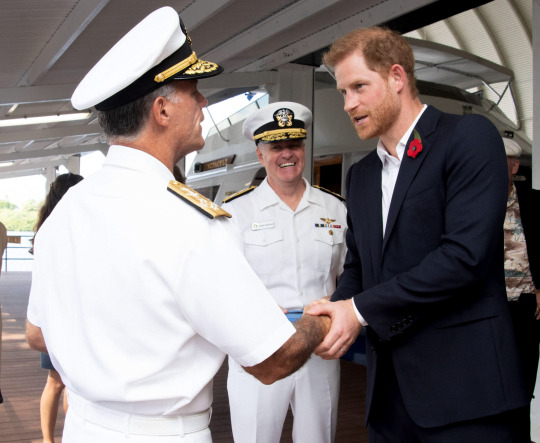
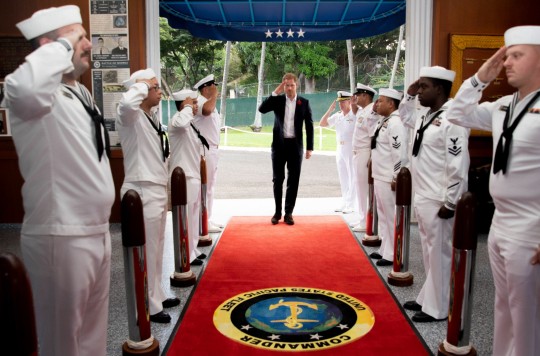
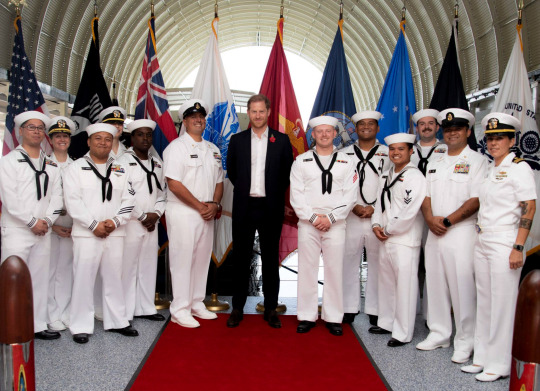
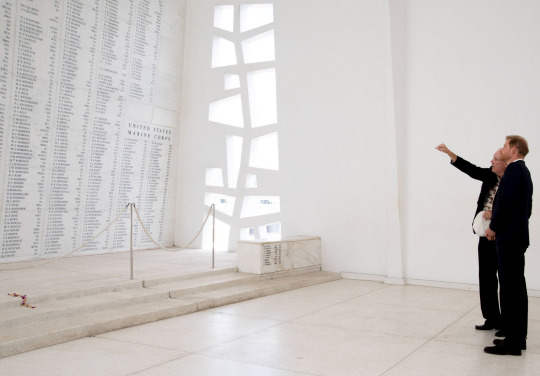
"In November, ahead of the 81st commemoration of Pearl Harbor Day, The Duke of Sussex visited Pearl Harbor National Memorial in Honolulu – a monument honoring the thousands of servicemembers and civilians affected by the tragedy. As part of The Duke’s continued commitment to remembering and honoring military personnel, veterans and families, he toured the sites of the USS Missouri and the USS Arizona alongside Admiral Samuel Paparo (Commander, U.S. Pacific Fleet) and Admiral John Aquilino (Commander, U.S Indo Pacific Command), paying his respects with a ceremonial laying of flowers at the reflection pool."
From: Archewell website.
72 notes
·
View notes
Text
North Korea said a second attempt to put a spy satellite into orbit failed early Thursday, but the reclusive country vowed to launch another in the coming months.
The Malligyeong-1 reconnaissance satellite was mounted on a new type of carrier rocket called the Chollima-1 and launched from a station in North Pyongan province in the early morning hours, according to the state-run Korea Central News Agency (KCNA). The first and second stages "all flew normally, but failed due to an error in the emergency explosion system during the flight of the third stage," KCNA said in a statement.
North Korea's National Aerospace Development Administration is investigating the cause of the accident and plans to attempt a third launch in October, according to KCNA.
North Korea attempted to launch its first spy satellite on May 31, but it crashed into the West Sea after an "abnormal starting" of the second-stage engine, KCNA said at the time.
MORE: North Korea satellite launch fails, with another promised as 'soon as possible'
In 2018, North Korea claimed to have put a satellite into space but international analysts later said that wasn't true.
Thursday's second attempt coincided with joint military drills between South Korea and the United States, which North Korea has long denounced.
The U.S., South Korea and Japan all issued statements "strongly" condemning North Korea's use of ballistic missile technology for its launch, which despite its failure they said is in violation of United Nations Security Council resolutions. The three allies also reaffirmed their commitment to work closely together to achieve "complete denuclearization" of North Korea in line with the U.N. Security Council resolutions.
"This space launch involved technologies that are directly related to the DPRK intercontinental ballistic missile program," Adrienne Watson, spokesperson for the U.S. National Security Council, said in a statement, using the acronym for North Korea's official name. "The President’s national security team is assessing the situation in close coordination with our allies and partners."
"The door has not closed on diplomacy but Pyongyang must immediately cease its provocative actions and instead choose engagement," Watson added. "The United States will take all necessary measures to ensure the security of the American homeland and the defense of our Republic of Korea and Japanese allies."MORE: US, Japan and South Korea's leaders hold historic meeting as threats from China, North Korea loom large
The incident was assessed as not posting "an immediate threat to U.S. personnel, territory, or that of our allies," according to a statement from the U.S. Indo-Pacific Command, which noted that it would "continue to monitor the situation."
South Korea’s Joint Chiefs of Staff said in a statement the military "was prepared in advance through identifying signs of an imminent launch."
The office for Japanese Foreign Minister Yoshimasa Hayashi confirmed that he held a telephone call with his South Korean and U.S. counterparts on Thursday morning to discuss North Korea's latest ballistic missile launch. The three officials agreed that the launches are happening "in an unprecedented frequency and in new manners" and that they "constitute a grave and imminent threat to the regional security and pose a clear and serious challenge to the international community," according to a statement from the Japanese Ministry of Foreign Affairs.
The Group of Seven, an intergovernmental political forum consisting of Canada, France, Germany, Italy, Japan, the United Kingdom and the U.S., also released a statement condemning "in the strongest terms" North Korea's launch.
12 notes
·
View notes
Text
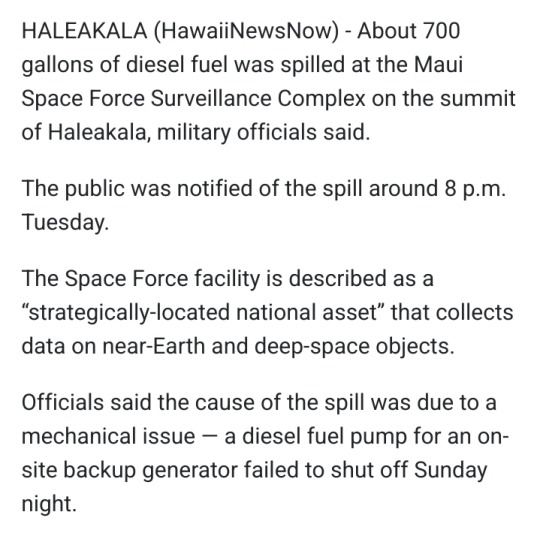

[image text: "HALEAKALA (HawaiiNewsNow) - About 700 gallons of diesel fuel was spilled at the Maui Space Force Surveillance Complex on the summit of Haleakala, military officials said.
The public was notified of the spill around 8 p.m. Tuesday.
The Space Force facility is described as a “strategically-located national asset” that collects data on near-Earth and deep-space objects.
Officials said the cause of the spill was due to a mechanical issue — a diesel fuel pump for an on-site backup generator failed to shut off Sunday night.
The next morning at about 8 a.m., site maintenance personnel noticed the problem and immediately deactivated the transfer pump, but not before 800 gallons of fuel leaked out.
Fuel spill experts from the Air Force Installation and Mission Support Center will assess the site to begin remediation efforts.
“We understand the importance of being good stewards of the environment and will work with necessary state and federal officials as we begin clean-up efforts,” said Brig. Gen. Anthony Mastalir, commander of U.S. Space Forces Indo-Pacific." /text]
what the fuck.
37 notes
·
View notes
Text
There’s growing skepticism among the American public about U.S. commitments abroad, matched with growing doubt among allies and partners—monitoring political currents in the United States—about the credibility of those commitments. Even for those who still retain faith in Washington, concern is rising about U.S. capacity to meet its commitments, considering increased demands on U.S. attention and resources amid ongoing wars in Ukraine and the Middle East. Observers question if the United States can properly meet what it calls its pacing challenge—China—in the Indo-Pacific or beyond.
Defense Secretary Lloyd Austin and other U.S. officials have argued that the United States can walk and chew gum at the same time, mainly because of its unparalleled network of allies and partners. To uphold what it calls the rules-based international order, Washington has increasingly leaned upon existing alliances and partnerships that exist largely outside of the multilateral institutions that previously underpinned that order, such as the United Nations and World Trade Organization.
Instead, Washington has sought to strengthen long-standing treaty alliances (i.e., NATO as well as the U.S.-Japan and U.S.-South Korea alliances) and tried to reenergize or establish various minilateral bodies throughout the Indo-Pacific, ranging from the Quad (Australia, India, Japan, and the United States) and AUKUS (Australia, the United Kingdom, and the United States) to IPEF (Indo-Pacific Economic Framework for Prosperity) and Chip-4 (a proposed grouping of Japan, South Korea, Taiwan, and the United States). However, these groupings have achieved only limited traction and continue to face significant hurdles.
The United Nations Command (UNC), a U.S.-led multinational command headquartered in South Korea (formally named the Republic of Korea, or ROK), is often overlooked in discussions of the minilateral architecture that Washington hopes to construct in the Indo-Pacific. To be sure, there are good reasons for this. The UNC has a narrow scope, and its own history was marked by long periods when it was understaffed and relatively unimportant, even on the Korean Peninsula.
Nevertheless, the UNC has a much longer history and is far more institutionalized than other minilaterals, such as the Quad or AUKUS. If the broader multilateral architecture has fallen into disrepair, building a latticework of institutions and bodies underneath it may be the next best alternative. The recent ROK-UNC defense ministerial meeting provides an opportunity to underscore recent efforts to modernize the UNC.
The UNC was established in the early stages of the Korean War as a U.S.-led, multinational warfighting command, made up of 15 member states that sent forces and five others that provided medical or humanitarian assistance. However, UNC member state commitment quickly waned after the armistice was signed and most members withdrew their forces.
And following the establishment of the U.S.-ROK Combined Forces Command in 1978, all warfighting responsibilities were passed from the UNC to that group, while the UNC remained focused on implementing, managing, and enforcing the armistice. Over the next 20 years, it was deemphasized and understaffed.
In the early 2000s, South Korea’s remarkable political and economic transformation resulted in many UNC member states, such as Australia, Canada, and the U.K., strengthening diplomatic ties with Seoul and, by extension, recommitting in various ways to the UNC. Improved inter-Korean relations brought increased attention to the UNC’s role overseeing the demilitarized zone and military demarcation line between the two Koreas. Additionally, North Korea’s nuclear program meant the UNC’s armistice enforcement responsibilities took on added significance. Successive four-star U.S. commanders in chief of the UNC began to see increased involvement by the group’s member states as an untapped resource.
Starting in 2008, a multinational coordination center was established under United States Forces Korea, a U.S. unilateral command, but later folded into the UNC as part of the broader so-called revitalization campaign begun in 2015 (and ended in 2018). The center facilitates multinational planning and coordination in and outside of U.S.-ROK military exercises.
In 2018, the Canadian and U.S. governments co-hosted the Vancouver Foreign Ministers’ Meeting on Security and Stability on the Korean Peninsula. It brought together 18 foreign ministers from the ROK, Japan, and UNC member states that provided support to Seoul during the Korean War, marking the first diplomatic consultation based upon UNC affiliation since the war. And since 2018, successive Canadian, Australian, and U.K. officers have served as the deputy commander at the UNC headquarters, with another Canadian three-star general recently appointed to the position.
Under the new terminology of UNC “modernization,” the U.S.-ROK alliance has welcomed increased member state involvement on the Korean Peninsula, with Washington and Seoul aligning their messaging on the issue. For example, during the alliance’s Ulchi Freedom Shield combined military exercises in August, ROK and U.S. officials announced the participation of UNC personnel in a joint statement, a subtle yet noteworthy shift in strategic communication given that previous announcements were unilaterally made by United States Forces Korea.
Moreover, the ROK itself has begun to welcome greater UNC member state participation in its own military activities. In October, bomb disposal teams from Belgium, Canada, New Zealand, and the Philippines, alongside U.S. personnel and naval assets, participated in South Korea’s multinational mine warfare drills. Simultaneously, ROK and U.K. forces engaged in combined, high-tech military training drills at the Korea Combat Training Center, which included a company of the British Army’s Scots Guards.
Importantly, South Korean President Yoon Suk-yeol has been outspoken in his praise of the UNC as playing a critical role in peace on the Korean Peninsula. This stance differs from both his progressive and conservative predecessors, who criticized the UNC for infringing on South Korean sovereignty, whether by limiting inter-Korean engagement or hamstringing the ROK’s self-defensive measures against North Korean provocations. Yoon has also openly noted that the UNC’s rear bases and facilities in Japan play an important role in deterring North Korea, marking one part of a broader effort to boost bilateral ROK-Japan ties.
The ROK-UNC Member States Defense Ministerial Meeting held on Nov. 14 in Seoul, the day after the annual U.S.-ROK Security Consultative Meeting, built upon these previous efforts. The meeting was notable in that it was the first such meeting hosted by the ROK and combined defense ministers and representatives from 17 UNC member states, although only South Korea and United States sent their highest-level defense officials.
In addition to honoring the past contributions and sacrifices of member states, one outcome of the meeting was the participants’ determination to “continue increasing mutual exchange and cooperation between the ROK-U.S. Alliance and UNC Member States to inform our combined training and exercises”; in other words, to build upon existing efforts.
The participants’ joint statement was also of note, declaring “that they will be united upon any renewal of hostilities or armed attack on the Korean Peninsula challenging the principles of the United Nations and the security of the Republic of Korea.” The statement offered a toned-down rehashing of the so-called Greater Sanctions Statement released during the Korean War.
Unlike the 1952 statement, this year’s version jettisoned mention of being “prompt to resist” or expanding the conflict beyond the frontiers of the Korean Peninsula, even though any renewed conflict in Korea would almost certainly expand beyond the peninsula and do so quickly.
The November meeting’s value was more symbolic than substantive. Nonetheless, it provides a framework upon which to build in the future. This could be done in several ways.
First, beginning with this inaugural meeting and in addition to South Korea’s continued strengthening of bilateral relations with individual UNC member states, an official multilateral diplomatic consultative body should be created under the UNC’s name. And South Korea should take a leading role as a host nation of the annual gathering. Currently, the U.S. four-star commander of the UNC/CFC/USFK presides over a regular roundtable attended by ambassadors (and military attaches) from each member country.
However, the UNC should also create and convene the new consultative body, with annual meetings led by South Korea’s Defense or Foreign Ministry. Over time, it also may be worthwhile for other UNC member states not only to increase the level of defense officials attending, but also to host such meetings in their home countries, signaling to their publics the importance of the commitment.
Second, for substantive military cooperation, member states’ participation in the UNC’s “force-providing” mission is necessary. Up to this point, UNC member states have been reticent to clearly delineate what sort of contribution they could or would make in the case of a renewal of hostilities—but they need to indicate more clearly what assistance they could offer.
Further down the road, the UNC should develop an institutional framework for the provision of forces. Once tasks and resources are allocated based on member states’ capabilities and willingness, the UNC should establish institutional mechanisms for government-level requests. Strengthening both multilateral and bilateral cooperation will emphasize South Korea’s responsibility and leadership, especially as the alliance moves toward a future-oriented, ROK-led Combined Forces Command.
Visiting force agreements would clarify South Korea’s status as a host nation and facilitate stable and institutionalized force contributions from member states. These agreements can have several benefits, including strengthening diplomatic cooperation among UNC members, mitigating domestic political resistance in member states, and expediting the process of readying forces for combat. Given that both the United States (as the lead nation) and South Korea (as the host nation) are invested in this process, a compromise approach to negotiating these visiting force agreements is necessary.
Third, following the joint communique released after the recent U.S.-ROK Security Consultative Meeting, Washington and Seoul should seek to broaden UNC membership through the participation of like-minded countries that share values with the ROK and the United States, anchored in the principles and mandates of the U.N. Charter. This should start with South Korea adding its own general-level officers to the UNC; move on to adding previous member states, such as India and Germany; and potentially expand to others where the situation is currently politically fraught, such as Japan.
Fourth, more effort should go into public diplomacy within South Korea to garner support for modernizing the UNC. The ROK-UNC meeting already caused blowback from Pyongyang, which called it a “dangerous scheme to ignite a new war of aggression.” Beijing also likely views any upgrading of the UNC with profound skepticism. If improved U.S.-ROK-Japan trilateral relations are seen by Pyongyang and Beijing as the creation of an Asian NATO, then a more robust UNC—along the lines recommended above—would only enhance that feeling, which is one that some South Koreans share.
That would require smart public diplomacy to counter. This messaging should emphasize that rather than a U.S.-led militarization strategy that compromises Korean sovereignty, the process would require Seoul’s leadership. And no UNC member state is going to increase and regularize its commitment without determining that it’s in its own interest to do so and that its voice will be heard. In fact, such a process will reduce, relatively speaking, the U.S. ability to shape the environment, since Washington will need to incorporate allied and partner perspectives into both peacetime and crisis-oriented planning.
Moreover, growing multilateral consultation and diplomatic signaling around maintaining peace and stability on the peninsula could help shift some of the balance away from nuclear blandishments and strategic asset deployments as the optimal way to deter North Korea. It may help reduce the temperature by growing the team. Finally, given the intense demands on U.S. resources and attention, it behooves all stakeholders involved to think hard now about ways to upgrade the UNC.
Washington calls North Korea a “persistent threat.” But from Seoul’s view, it is a steadily worsening one. Seoul needs more partners willing to support its defense. For Washington, which had serious doubts about its ability to meet the challenge from China even before the intensification of conflicts in Europe and the Middle East, inviting greater and more formalized allied contributions to the UNC makes sense, especially before a crisis or conflict forces its hand.
The innumerable, complex challenges and enormous demands on U.S. forces and resources in a potential conflict with China are such that Washington needs to clarify what other allies and partners can bring to bear. Shoring up these commitments now, during peacetime, would not only help with preparedness, but also send a powerful collective deterrent signal, thus reducing the chances of conflict to begin with.
A true peace on the peninsula may continue to elude the United States, China, and the two Koreas (at least for the foreseeable future). At the very least, efforts should be made to stabilize the armistice.
3 notes
·
View notes
Text

SOUTH CHINA SEA (July 27, 2022) The U.S. Navy’s only forward-deployed aircraft carrier USS Ronald Reagan (CVN 76) approaches the Military Sealift Command fleet replenishment oiler USNS Tippecanoe (T-AO 199) to conduct a fueling-at-sea. During the evolution, Tippecanoe transported fuel to Ronald Reagan via connected replenishment. Ronald Reagan, the flagship of Carrier Strike Group 5, provides a combat-ready force that protects and defends the United States, and supports alliances, partnerships and collective maritime interests in the Indo-Pacific region. (U.S. Navy photo by Mass Communication Specialist 3rd Class Daniel G. Providakes
29 notes
·
View notes
Video
#USINDOPACOM#U.S. Indo-Pacific Command#FBI#FBI SWAT#Specialized Weapons and Tactics#Federal Bureau Of Investigation#Joint Base Elmendorf-Richardson#Alaska#USA#flickr
2 notes
·
View notes
Text
The RIMPAC exercise once again underscores the role of the islands and region in warfighting strategy as well as the complex and even paradoxical nature of “defending” and “protecting.” This is especially true for the island of Guam, the homeland of the indigenous CHamoru people. In Guam, military officials from the Joint Region Marianas assure the residents (and the indigenous CHamoru population) that the United States will continue to protect Guam against all threats, asking them to not be alarmed by military developments.[...]
The axis of the U.S. Indo-Pacific strategy seems to revolve around Guam. As a U.S. territory, Guam serves as a reliable location for logistics, power projection, and deterrence. Or, as the Hudson Institute puts it, “this US territory is essential to the security of the American citizenry.”[...]
High-ranking officials, such as former head of Indo-Pacific Command, Admiral Phil Davidson, have testified before Congress on the importance of Guam: “I have repeatedly stated the most important action we can take to increase the joint force’s lethality is to introduce a 360-degree, persistent, air and missile defense capability on Guam.” [...]
Guam’s role as a militarized, strategically located unincorporated territory has various cultural, environmental, and economic effects, including the occupation of 27 percent of the island’s land by the US military. The latest geopolitical maneuvering of great powers adds another element to the threat against Guam, which makes itself visible through the layers of missile defense. [...]
Guam’s role as a militarized, strategically located unincorporated territory has various cultural, environmental, and economic effects, including the occupation of 27 percent of the island’s land by the US military. The latest geopolitical maneuvering of great powers adds another element to the threat against Guam, which makes itself visible through the layers of missile defense.[...]
military officials have said, Guam is not a place to simply fight from, it must now be fought for. They stress the urgency and timely nature of defending the island’s vulnerabilities, while simultaneously arguing that this will not provoke China. Rather, Guam’s missile defense becomes a key to deterrence in the region. U.S. forces and facilities in the island would enable a drawn-out conflict, which China does not want. [...]
Resiliency in Guam military operations does not translate into resiliency for the island’s society. The threat of deterrence failing should send chills down our spines, but we should also consider who placed the target on our heads in the first place. The conversation about missile defense and Guam’s future in a conflict with China must include those who bask in the warm Guam sun, feel the Guam wind on their skin, or are rooted generations deep in the island’s soil.
20 Jul 2022
25 notes
·
View notes
Text
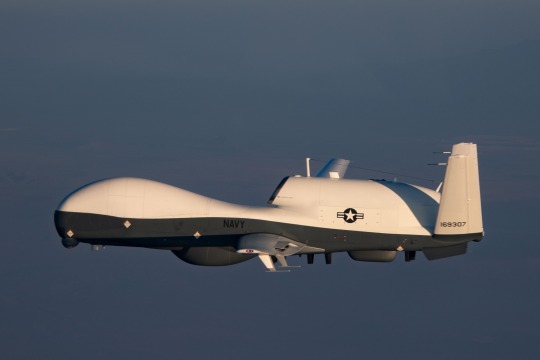
U.S. Navy declares IOC for its new UAS reconnaissance MQ-4C Triton
Fernando Valduga By Fernando Valduga 09/15/2023 - 14:00 in Military, UAV - UAV
The U.S. Navy officially declared the initial operational capability (IOC) of Northrop Grumman Corporation's MQ-4C Triton multi-manned unmanned aircraft on September 14.
Since its Early Operational Capability (EOC) milestone in May 2020, the MQ-4C Triton has operated within the U.S. Navy Pacific Fleet, conducting maritime intelligence, surveillance and reconnaissance (ISR) missions in the area of responsibility of the U.S. Indo-Pacific Command as the Navy's only unmanned, high-altitude, long-lived aircraft.
The MQ-4C Triton, manufactured for use by the U.S. Navy and the Royal Australian Air Force (RAAF), supports a wide range of missions. These include maritime patrol, signal intelligence, search and rescue operations, as well as communications relay tasks.
According to the producer, these aircraft offer persistent surveillance capabilities, assisting in predicting opposing actions and facilitating more effective joint military efforts and enterprises.
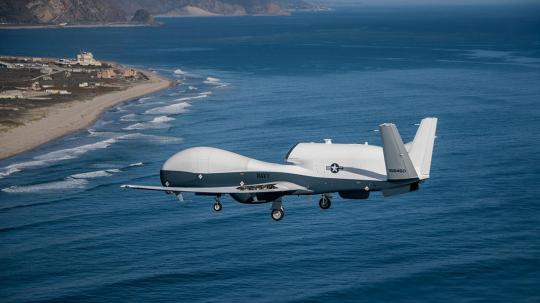
Operating at altitudes above 50,000 feet and boasting a 24-hour resistance, the Triton serves as a continuous communications retransmission center, ensuring connectivity between dispersed Navy units, while allowing commanders to operate with a shared operational overview.
“The Triton proved to be invaluable for the maritime patrol and reconnaissance mission in the Indo-Pacific. Now that the system has reached its initial operational capacity, commanders will be able to take full advantage of Triton's powerful set of sensors to detect and stop potential opponents around the world," said Rho Cauley Bruner, director of the Triton program at Northrop Grumman.
"The persistent global maritime awareness is fundamental to deter, or compete and win, our opponents. Triton ensures that we are making informed decisions and operating effectively anywhere in the world," added Captain Josh Guerre, manager of the U.S. Navy's persistent unmanned aircraft systems program.
Northrop Grumman provided the U.S. Navy with a total of five Triton aircraft equipped with multiple intelligence capabilities, with the most recent delivery occurring in June 2023.
Tags: Military AviationNorthrop Grumman MQ-4C TritonUASUSN - United States Navy/U.S. Navy
Sharing
tweet
Fernando Valduga
Fernando Valduga
Aviation photographer and pilot since 1992, he has participated in several events and air operations, such as Cruzex, AirVenture, Daytona Airshow and FIDAE. He has work published in specialized aviation magazines in Brazil and abroad. Uses Canon equipment during his photographic work throughout the world of aviation.
Related news
MILITARY
Lockheed Martin receives US$ 151.4 million to manufacture F-16 Block 70 fighters for Bulgaria
15/09/2023 - 13:00
MILITARY
Bell and USAF will test high-speed vertical takeoff and landing module
15/09/2023 - 11:00
MILITARY
Denmark welcomes the first four F-35 fighters that land on Danish territory
09/15/2023 - 08:29
BRAZILIAN AIR FORCE
FAB C-130 Hercules aircraft uses Datalink Engine Tactical System in SAR training
09/14/2023 - 20:00
MILITARY
Aeralis presents improvements in the concept of Airflex modular combat coach
09/14/2023 - 16:00
MILITARY
The second KC-130J destined for Germany flies
14/09/2023 - 15:00
30 notes
·
View notes
Text
Get Ready for Fort Liberty: The Pentagon Begins Changing Confederate Base Names | Military.com
The Pentagon has started the process of renaming Fort Bragg and other bases, as well as ships and hundreds of signs and roads, as it plans to scrub ties to the Confederacy from all installations by the start of 2024.
William LaPlante, the undersecretary of defense for acquisition and sustainment, directed all Department of Defense organizations to implement this week the recommendations handed down by the Naming Commission, an independent panel created by Congress and charged with reviewing and replacing the names, according to a press release.
It's a heavy undertaking that includes new names for nine Army bases -- Bragg will become Fort Liberty -- two Navy ships and upward of 1,000 other items located on America's military installations. But Brig. Gen. Pat Ryder, the Pentagon's press secretary, told reporters Wednesday he was optimistic it could all be done within the year.
Read Next: States Must Recognize Military Spouses' Job Licenses After Moves Under New Law
"I think we are confident, you know, each of the services has clear instructions in terms of what it is that they need to focus on, and where the secretary is confident that the services are and will continue to take that seriously," he said.
Ryder did not have an updated figure on what it would cost to take on all of the recommendations from the Naming Commission. The latest estimate from the group, released this past September, was a total of $62.5 million.
Katherine Kuzminski, a senior fellow at the Center for a New American Security think tank who researches military culture, told Military.com on Friday that the DoD has dealt with renaming operations in the past.
In 2018, then-Defense Secretary Jim Mattis announced that the U.S. Pacific Command would become the U.S. Indo-Pacific Command, a shift that required changes ranging from signs to stationery.
Kuzminski said that was accomplished in a relatively short period of time. She added that senior leaders in the military can also start referring to those Army bases by their new names right now to help make them commonplace.
"You do have to think about all of the details such as who owns what signage or when exits on interstates will be changed," Kuzminski said. "But we can start referring to these installations like Fort Liberty by these new names and it can get at what the Naming Commission was doing, which was changing the culture."
Kuzminski said it's possible cost estimates could go up as the Pentagon starts to unravel how involved the renaming and replacing process is.
Department of Defense officials began to reckon with the military's long history of honoring namesakes tied to the rebel army that fought in the Civil War following George Floyd's murder at the hands of police, which subsequently sparked nationwide anti-racism protests.
The Naming Commission was established in the 2021 National Defense Authorization Act and began submitting its first report cataloging those Confederate-linked names on military bases in May 2022. Defense Secretary Lloyd Austin accepted the commission's recommendations this last September.
The group identified nine Army bases, including Fort Bragg, North Carolina, and Fort Benning, Georgia, which are both named for Confederate officers.
They recommended Benning be renamed Fort Moore, after Lt. Gen. Hal Moore, who led men during the Vietnam War, and his wife Julia. The cost of renaming all of those bases will come to around $21 million, by the Naming Commission's estimates.
Additionally, the Navy identified the USS Chancellorsville, named after a Civil War battle with a Confederate victory, and the USNS Maury, named after Matthew Fontaine Maury, who left the Navy to sail for the Confederacy, according to the Pentagon. The commission did not provide new name recommendations for those vessels.
The commission also identified Confederate officers recognized on campus at West Point and the U.S. Naval Academy, which will cost an estimated $450,000 to replace.
The largest amount of assets would be various roads, signs, buildings and street names throughout the Pentagon's portfolio, which would account for nearly $41 million of the cost.
Editor’s note: The Pentagon said in a Jan. 5 press release that The Confederate Memorial at Arlington National Cemetery was being disassembled. A spokesman for Arlington National Cemetery contacted Military.com after publication to say that the information provided by the Department of Defense was incorrect. A paragraph reporting that detail has been removed from the story. A plan for the removal of the monument is still being developed, the spokesman said.
#Get Ready for Fort Liberty: The Pentagon Begins Changing Confederate Base Names#base name changes#us military base#us military base name changes
2 notes
·
View notes
Text

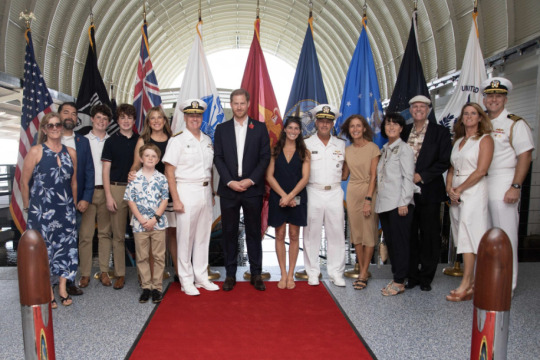
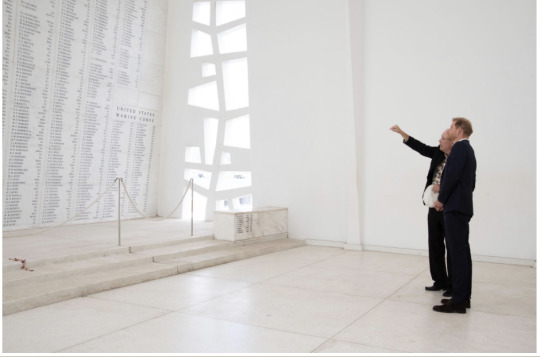
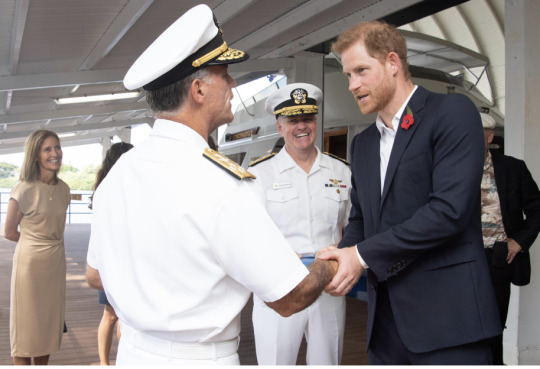
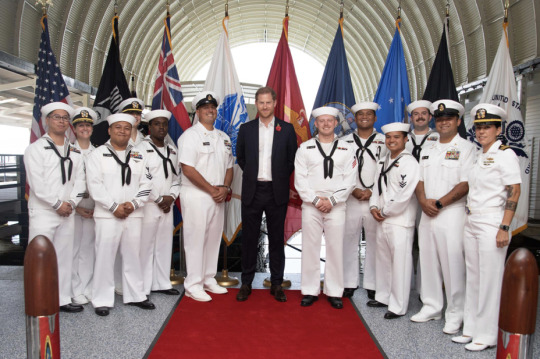
In November, ahead of the 81st commemoration of Pearl Harbor Day, The Duke of Sussex visited Pearl Harbor National Memorial in Honolulu – a monument honoring the thousands of servicemembers and civilians affected by the tragedy. As part of The Duke’s continued commitment to remembering and honoring military personnel, veterans and families, he toured the sites of the USS Missouri and the USS Arizona alongside Admiral Samuel Paparo (Commander, U.S. Pacific Fleet) and Admiral John Aquilino (Commander, U.S Indo Pacific Command), paying his respects with a ceremonial laying of flowers at the reflection pool.
Link
8 notes
·
View notes
Video
220920-N-BR419-1012 by U.S. Pacific Fleet
Via Flickr:
PHILIPPINE SEA (Sept. 20, 2022) Navy’s only forward-deployed aircraft carrier, USS Ronald Reagan (CVN 76), prepares to come alongside the Military Sealift Command fleet replenishment oiler, USNS Rappahannock (T-AO 204), for a fueling-at-sea in the Philippine Sea. Fueling-at-sea increases the capability of Navy’s carrier force, allowing ships to stay at sea indefinitely by providing aviation fuel anywhere in the world. Ronald Reagan, flagship of Carrier Strike Group 5, provides a combat-ready force that protects and defends the United States, and supports alliances, partnerships and collective maritime interests in the Indo-Pacific region. (U.S. Navy photo by Mass Communication Specialist 3rd Class Oswald Felix Jr.)
13 notes
·
View notes
Text
Requires the Secretary of Defense to deliver additional details on the budgetary
effects of inflation with the annual submission of the President's budget.
Requires the establishment of a Civilian Protection Center of Excellence to serve as
the focal point for matters related to civilian casualties and other forms of civilian
harm resulting from military operations involving United States Armed Forces and
authorizes an additional $25 million for implementation of the Civilian Harm Mitigation
and Response Action Plan.
Authorizes increased support for Joint All-Domain Command and Control, including
establishment of a Joint Force Headquarters in U.S. Indo-Pacific Command, effects
chain and mission-based command and control experimentation, novel kill chain
development, and acceleration and integration of the Family of Integrated Targeting
Cells.
Requires the Secretary of Defense to develop a Joint Concept for Competing.
Increases the number of Assistant Secretaries of Defense to 19, the number of Deputy
Assistant Secretaries of Defense to 60, makes technical and conforming edits, and
designates one of the new ASD positions specifically for Cyber Policy.
Updates the management reform framework for the Department of Defense, including
improved tracking and assessment of cost savings from reform initiatives, as well as
reform-focused research.
Requires the Secretary of Defense to conduct a demonstration of a strategic
management dashboard to automate the data collection and visualization of the
primary management goals of the Department of Defense.
Authorizes an increase of $37.2 million for Overseas Humanitarian, Disaster, and Civic
Aid.
Requires the establishment of a government-industry-academia working group for
microelectronics to provide a forum for information sharing and consultation on areas
of mutual interest related to microelectronics research, development, and
manufacturing.
2 notes
·
View notes
Text
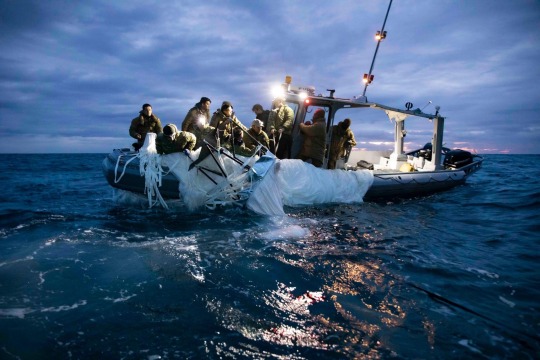
spy balloon remnants: underwhelming without all the hot air
[Ian Bremmer]
* * * *
February 6, 2023
Heather Cox Richardson
The Chinese spy balloon shot down off South Carolina on Saturday after spending four days in U.S. airspace will almost certainly make the history books but not because, by itself, it is a hugely significant factor in the changing relationship between the U.S. and China under President Joe Biden. The reason the balloon will be remembered in the future is that the Republican response to it has been so completely unrelated to reality, and has been so magnified by the media, that it has provided a window into the dysfunction of modern politics.
The facts are these: On Saturday, January 28, a Chinese airship entered U.S. airspace north of the Aleutian Islands, then crossed Alaska. It left U.S. airspace, then reentered over northern Idaho on Tuesday, January 31. On February 1 it was over Montana. On February 3 it was near St. Louis, Missouri. On Saturday, February 4, the pilot of an Air Force F-22 shot the airship down in shallow water off the coast of South Carolina, where the wreckage could be recovered.
The Trump administration had an inconsistent relationship with China. Trump attacked China in a trade war early in his presidency, placing tariffs on a range of products (which induced China to retaliate, prompting Trump to pump $28 billion into the U.S. farming sector to compensate for lost revenue). But by 2019, according to Trump’s national security advisor John Bolton, Trump “pleaded” with Chinese leader Xi Jinping to help him get reelected in 2020, and inked a deal for China to buy significant amounts of the farm products it had turned to other countries to provide after the tariffs (that was why Trump downplayed China’s role in hiding Covid in the early months of 2020). According to former representative Adam Kinzinger (R-IL), Trump also asked congressional leaders to “lay off” Xi, because Trump didn’t want to disappoint Xi.
In contrast, Biden and Secretary of State Antony Blinken have worked to counter China by building Indo-Pacific cooperation, reinforced U.S. support for Taiwan, established export controls on technology that have hamstrung the Chinese semiconductor industry, worked to counter Chinese investment in Africa, and enhanced security cooperation with South Korea and Japan.
But the balloon sparked a frenzy from Republicans insisting that Biden had been weak on China or even was working for China: right-wing talk show host Mark Levin said Biden is “bought and paid for by the Communist Chinese government,” and former president Trump said that Biden “has surrendered American airspace to Communist China.” Senator Marco Rubio (R-FL) said China was showing “that the United States is once-great superpower that’s hollowed out, it’s in decline.” South Carolina Republican representative Joe Wilson—the man who shouted “You lie” at President Obama—said that Biden and Vice President Kamala Harris should resign from office because of the balloon.
In fact, U.S. standing in the world has strengthened considerably since Biden took office, and the North Atlantic Treaty Organization (NATO), which Trump tried to scuttle, is strong enough that Sweden and Finland want to join.
It also turns out that at least three similar balloons crossed into U.S. airspace while Trump was president. Today, General Glen D. VanHerck, who oversees the North American Aerospace Defense Command, or NORAD, told reporters today that this weekend’s balloon was at least the fifth that had come into U.S. airspace, including at least three during Trump’s presidency, but that NORAD didn’t know about that until the intelligence community—under Biden—notified them.
As for the fact that Biden waited to shoot the thing down until it flew over the water, the administration says it did not want to take the risk of downing it over the American people. VanHerck estimated it weighed about 2,000 pounds, carried equipment the size of a regional jet, and was about 200 feet tall. As terrorism expert Malcolm Nance wrote on Twitter: “WHY let spy balloon in our space? 1) It was 18.5 miles up, almost in space. 2) it sends data link to PRC. We can intercept that & learn what China knows. We can jam it so they see nothing new. 3) The collection system is ours & can reconstruct it. They lose asset & we win spy game[.]” Indeed, U.S. officials say they blocked the instruments from gathering intelligence, and turned the tables to gather intelligence from the equipment itself.
You would think this balloon marks terrible U.S. weakness and is the most important thing to happen in years. But, in fact, the U.S. is stronger internationally than it has been in a while, and the balloon is just one more piece of a larger story about the changing relationship between China and the United States.
[Letters from an American]
6 notes
·
View notes